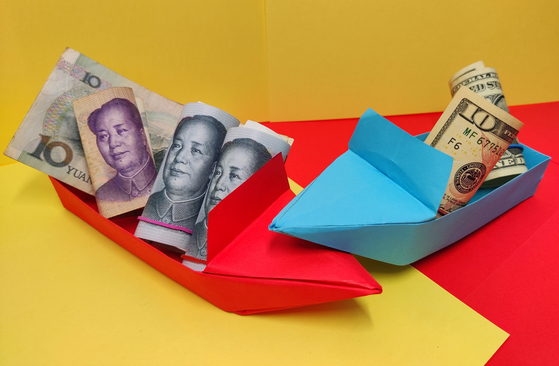No substitute for the U.S. dollar yet

Lee Sang-ryeol
The author is an editorial writer of the JoongAng Ilbo.
The theory of a U.S. dollar demise has resurfaced. The latest doomsayers are high-profile figures — European Central Bank President Christine Lagarde, Brazilian President Luiz Inacio Lula da Silva, Chinese President Xi Jinping, Saudi Crown Prince Mohammed bin Salman and Russian President Vladimir Putin.
Championing the end of the U.S. dollar
Speaking to the U.S. Council on Foreign Relations (CFR) on April 17, Lagarde pointed to a growing number of countries seeking to replace greenbacks for trade settlements, warning that the U.S. dollar as the “international, the global reserve and the transaction currency” with the euro in the second place “should no longer be taken for granted.” On April 13, Lula, during a visit to the New Development Bank in Shanghai, drummed up his campaign for a common currency for BRICS — Brazil, Russia, India, China and South Africa — similar to the euro. “Why can’t we do trade based on our own currency? Who was it that decided that the dollar was the currency after the disappearance of the gold standard?” he trumpeted.
Brazil and China have been playing a duet on the de-dollarization pitch. During recent summit talks, Lula and Xi elevated their bilateral ties to a “comprehensive strategic partnership.” They agreed to use their own currencies for the payments of trade and financial transactions instead of converting them to the U.S. dollar. They also agreed to shift to China’s Cross-Border Interbank Payment System, which processes payments in the Chinese yuan, instead of the dollar-based Society for Worldwide Interbank Financial Telecommunication most banks around the world use for communications about their cross-border transactions.
To build up the yuan’s rank, China has cozied up with the oil powerhouse Saudi Arabia. During his visit to Riyadh last December, Xi signed a “comprehensive strategic partnership” with Saudi’s Prince Mohammed. Xi proposed Gulf Arab leaders buy oil and gas in the yuan, shaking the long petrodollar dominance. China is the world’s largest crude oil importer. There are yet any signs that the oil trade between Saudi Arabia and China has actually been made in the Chinese currency. But the two are moving toward the goal. The Export-Import Bank of China has recently approved its first yuan-based loan to the Saudi National Bank — the largest bank in Saudi Arabia — to facilitate financing and trade between the two countries. Saudi Arabia’s state-owned oil company, Aramco, also decided to buy a 10 percent stake in Rongsheng Petrochemical Co., one of China’s refining giants, for 24.6 billion yuan ($3.6 billion).
China and Russia have never been closer. In a state visit to Russia in March, Xi agreed to reinforce bilateral cooperation with Putin. While Russia, isolated from the rest of the world, desperately needed trade with China, Xi wanted the yuan settlement for oil trade with Russia. Putin promised to use the yuan for Russia’s trade and promote the employment of the Chinese currency in Asia, Africa and Latin America.
Latin America’s economic powerhouse Brazil, the major oil producer Saudi Arabia, China and Russia all aspire to wean away from the mighty dollar and seek alternative payment sources. The movement perfectly matches China’s dream to escalate the international status of the yuan enough to replace the U.S. dollar. India started to pay for Russian gas in the ruble late last year.
Warning against the de-dollarization movement
Lagarde’s warning at the CFR, a major think tank of the U.S. State Department, stems from the new trade patterns — mostly among the BRICS — moving toward new alliances and transaction payment. If so, is the dollar dominance really at risk? Or is the danger exaggerated? Let’s check the statistics first.
According to the Bank for International Settlements, the U.S. dollar was behind 88 percent of all foreign exchange trades in 2022. In the SWIFT system, the greenback took up 45.4 percent as of January, above 33.3 percent for the euro, 3.3 percent for the Japanese yen, and 1.3 percent of the yuan.
But the currency reserve portfolio tells a bit different story. The greenback’s prowess is gradually waning according to the ratio of dollar weight in foreign exchange reserves. According to the International Monetary Fund, the U.S. dollar’s share of global FX reserves stood at 58.4 percent in the final quarter of 2022. Although the dollar remained dominant, the ratio sharply fell from 71.5 percent in 2001. The dollar’s share fell under 65 percent in the wake of the 2008 global financial crisis and under 60 percent in the final quarter of 2020. Its weight sank by more than 10 percentage points in the last 20 years. During the same period, the euro’s share slightly rose from 19.2 percent to 20.5 percent and the yen’s from 5 percent to 5.5 percent. The yuan made up 2.7 percent in the fourth quarter of 2022.
Overall, the dollar hegemony remains intact, but other currencies are slowly chipping away at its territory. According to Stephen Jen, CEO of Eurizon SLJ Capital, the dollar’s share as a global reserve currency last year fell at ten times the average pace of the past 20 years. “If the financial markets outside the U.S. thrive … and if the opposite happens in the U.S. … the dollar could very well meet its demise,” he cautioned. Still, despite the rhetorical defiance against the dollar, other currencies like the euro or the yuan have yet to gain confidence to replace the greenback.
Limits for other currencies as a global one
For a currency to be as mighty as the greenback, it must be backed by unquestionably strong economic and military power. Presently, no country is a match for the U.S. The capital market also should be open and reliable.

The dollar’s strongest appeal is its liquidity. The greenback is accepted in any parts of the world, including North Korea. The dollar did not become universal overnight. The U.S. government has allowed dollars to flow out to every part of the world at the cost of its ballooning fiscal and current-account deficits. No country can afford this.
Currencies challenging the dollar hegemony have fatal weaknesses. The second-most currency, the euro, is not tied to a single national government. Though the EU has a single monetary authority, or the European Central Bank, it lacks a single fiscal authority. For the yen, there are doubts about its value. The yen’s weakening has been fixated through Japan’s entrenched loose monetary and fiscal policy to fight deflation. For the yuan, Chinese authorities and their grip over the capital market are hurdles to the currency. The yuan cannot have international credibility due to Beijing’s frequent FX meddling and murky financial and fiscal management.
The Atlantic Council, a major U.S. think tank on international affairs, pointed to the lack of the will or ability of other countries to do what is necessary to become a contender to the U.S. reserve status. The de-dollarization has gained an impetus lately, but the dollar remains safe at the top. Bloomberg projected it could take decades for the mighty dollar to lose its power.
Sanctions-hit Russia and Iran’s resistance
The U.S. is partly at fault for losing fans for the dollar. Soon after Russia’s invasion of Ukraine, the U.S. and the EU ousted major Russian banks from the SWIFT messaging system used by banks for international transactions in the U.S. dollar. After Russia was isolated from financial and trade standards, it had to turn to alternative currencies to settle payments. For instance, payments for Russian exports in the yuan spiked to 16 percent from their pre-sanction 0.5 percent.
The Financial Times warned that such financial sanctions on Russia can dilute the dominance of the dollar and result in a more fragmented international monetary system. China’s Global Times pointed out that Iran, Russia and other countries are accelerating de-dollarization due to the heavy U.S. financial and economic sanctions. Washington is also aware of the risk. U.S. Treasury Secretary Janet Yellen told CNN, “There is a risk when we use financial sanctions linked to the role of the dollar that over time it could undermine the hegemony of the dollar … Of course, it does create a desire on the part of China, of Russia and of Iran to find an alternative.”
The weaponization of the dollar to sustain the U.S. influence and hegemony is ironically endangering the strength of the dollar. Financial sanctions became an easier alternative to military engagement, but the U.S. may be paying the price. And yet, Yellen defended financial sanctions as an “extremely important tool.” But if the U.S. continues leveraging the dollar to defend its global supremacy, the de-dollarization movement can accelerate. The almighty dollar’s power could hinge on the results of the global hegemony contest.










with the Korea JoongAng Daily
To write comments, please log in to one of the accounts.
Standards Board Policy (0/250자)